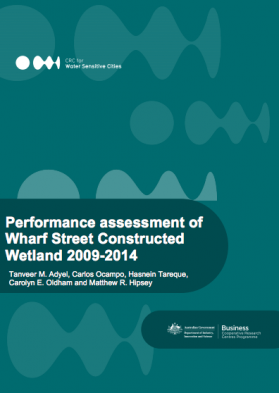Performance assessment of Wharf St Constructed Wetland 2009-2014
Abstract
This report summarises the results of a performance assessment of the Wharf Street Constructed Wetland (WSCW). WSCW is an artificial wetland on the Swan Coastal Plain of Western Australia with an area of about 1 hectare. It was constructed to improve the quality of urban stormwater runoff and reduce nutrients and other contaminants entering the Canning River from an urbanised 129ha catchment. The wetland is a multistage hybrid system containing vegetated and open water surface flow (SF) and vegetated subsurface flow (SSF) components. For this report the WSCW is segmented into four compartments, each containing at least one inflow and outflow. Initially the SSF compartment was constructed using recycled concrete material (RCM). But due to an alkalinity problem, in June 2012 approximately 1500 m³ of RCM was removed (all of SSF 1 and roughly half of SSF 2) and replaced by 25-40 mm screened washed laterite aggregate sourced from a quarry in the Perth hills. Minimum wetland water levels are maintained via a combination of pumped re-circulating wetland water and extraction from the superficial aquifer. The system has been the subject of regular monitoring of hydrology, water quality and ecology for the past seven years.
This report covers an analysis of all available historical data that has been collected from 2009 to 2014, with an overarching aim of gaining insights into the overall effectiveness of the wetland in treating urban stormwater. It attempts to give answers to a series of knowledge gaps related to the dynamics and performance of the urban wetland and recommend future monitoring and research activities.
